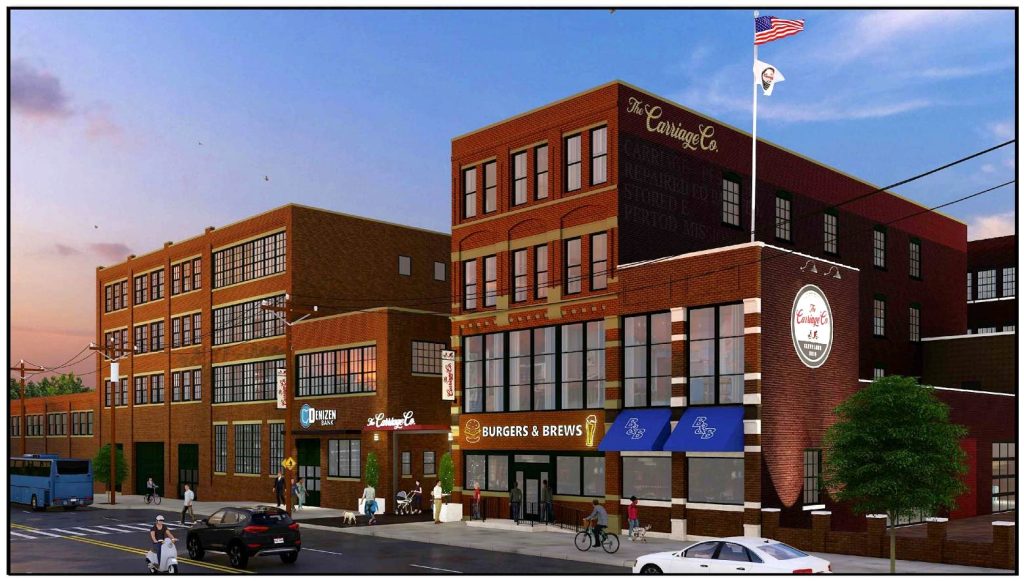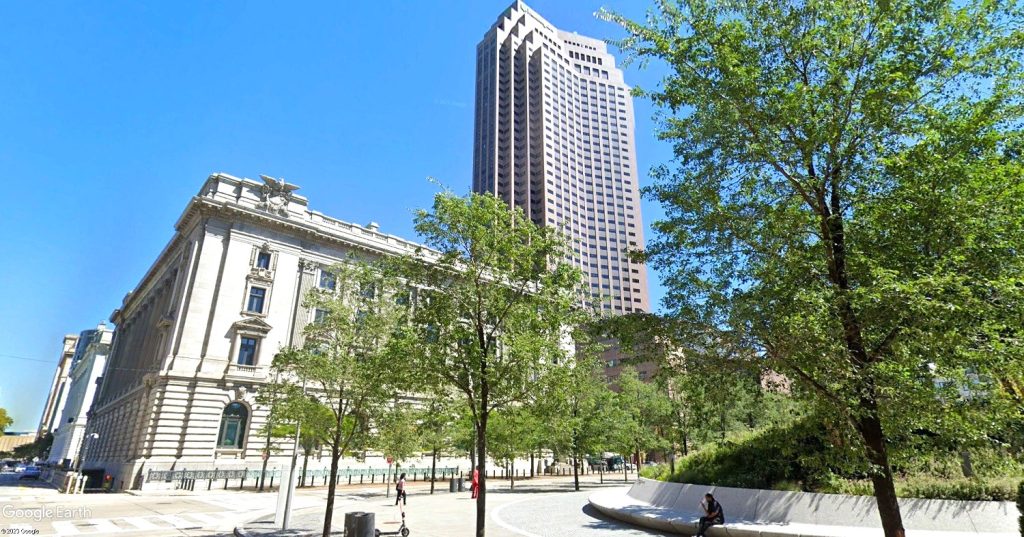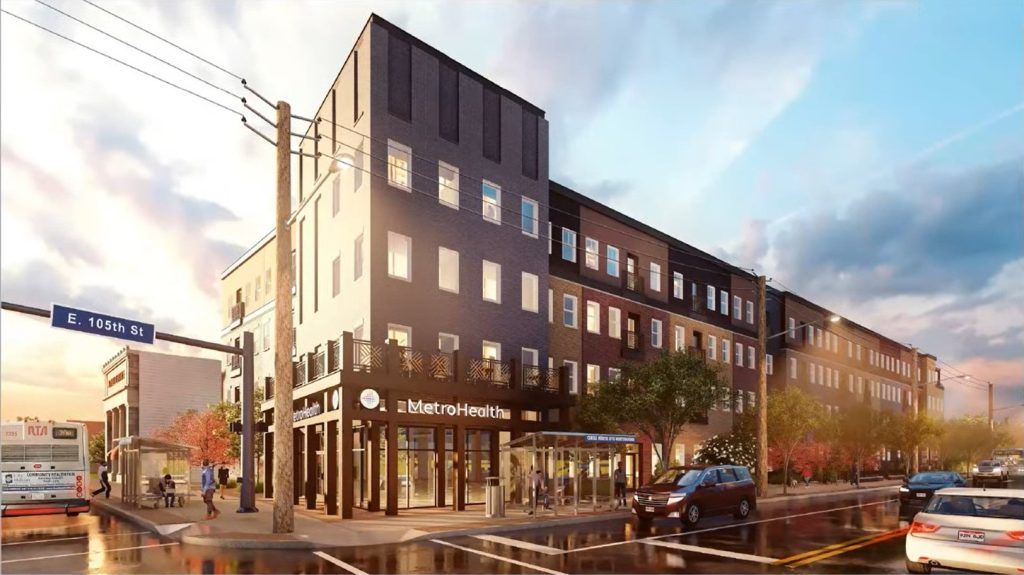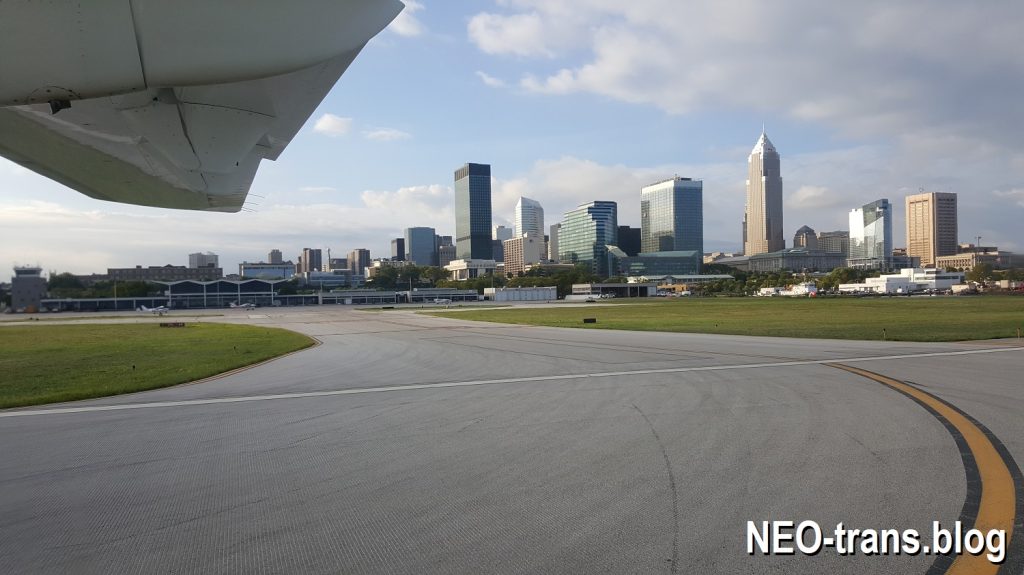
City and county officials reportedly are near to announcing a plan to close Burke Lakefront Airport next to the Downtown Cleveland. The question is, what replaces it? There are rumors that the owners of the Cleveland Browns are considering it as a site for a new domed stadium and more than $1 billion worth of supportive development (KJP). CLICK IMAGES TO ENLARGE THEM.
Two dozen stadium-area buildings possible

The Haslam Sports Group plans more than a billion dollars worth of new development surrounding their proposed new domed stadium. But is that necessarily going to be in the Cleveland suburb of Brook Park? With an emerging effort by city officials to close and redevelop Burke Lakefront Airport, look for that site to be offered up as a location for the stadium and supportive development. Rumors are circulating that both could happen.
NEOtrans has learned from three sources that Cleveland Mayor Justin Bibb may be close to announcing a plan for closing Burke and replace it with development and recreational spaces. A month ago, the city was ready to announce the plan but a source said city officials pulled it back at the last second for reasons unknown.
Any Burke closure plan depends on funding improvements to Cuyahoga County Airport and/or possibly other small airports in the region to offer the facilities that are the same or better than what Burke has.
The Federal Aviation Administration requires all Commercial Service Airports like Cleveland Hopkins International Airport to have a reliever airport in the same geographical area and to meet specific design and size minimums with regards to runway length, tarmac area, hangar spaces and terminal spaces. Burke has it; other nearby airports don’t. FAA probably will not allow Burke’s closure until another nearby airport like Cuyahoga County’s is expanded.
NEOtrans reached out to Bibb’s press secretary for confirmation and comment but has yet to hear back. Similarly, NEOtrans has heard rumors that the city has reached out to the Haslams and offered the 76-year-old airport as a site for the new Cleveland Browns Stadium and more than a billion dollars worth of supportive development. A Browns’ spokesman opened an e-mail from NEOtrans seeking comment but otherwise hasn’t responded.
The Burke site is huge, totaling 450 acres. Being able to develop that much land — or even a portion of it, should a significant percentage be dedicated to community recreation and parks — in a reasonable period of time would be a challenge. But there is a single end user that could fill a large share of it or at least try to.

One of the largest multi-building real estate developments underway in Greater Cleveland is the Circle Square development in University Circle. So far, nearly half of this 1-million-square-foot, $400 million development has been constructed. Because it is comprised almost entirely of high rises, it is more expensive per square foot than what the Haslam Sports Group is proposing (Bialosky).
It makes sense that the city may have offered Burke as a site for the Haslams to develop. The city wants to keep the Browns and its stadium in Cleveland. But the Haslams want more land than what the city has previously offered to achieve its ambitious development vision. That’s why the Haslams reportedly have a purchase agreement for 176 acres in suburban Brook Park, a story broken by NEOtrans last February.
Although the city cannot legally sell land that was reclaimed from Lake Erie, it can lease it. Burke was constructed by extending the shoreline out into the lake by using landfill. Under a master development agreement, the city could lease this former submerged land to the Haslams for a nominal fee (like $1 per year) for up to 99 years.
There, the Haslams could control revenues from the stadium, development rents, parking revenues and more. By contrast, Bibb seems to view the lakefront immediately north of downtown as an accessible social mixer for people of all incomes and backgrounds.
We already know that the Haslams want to build big for their new stadium. NEOtrans reported two years ago that the Haslams had first wanted to acquire land on the northeast edge of downtown, north of St. Clair Avenue and east of East 13th street, for a new stadium and supportive development. If the Municipal Parking Lot was included, it could amount to 70-100 acres, depending on how many parcels were ultimately secured.
Considering the large number of parcels in that area which would have to be acquired, the city was nervous that it would get bogged down in years-long negotiations with one or more reluctant sellers. The city didn’t want to have to resort to eminent domain.
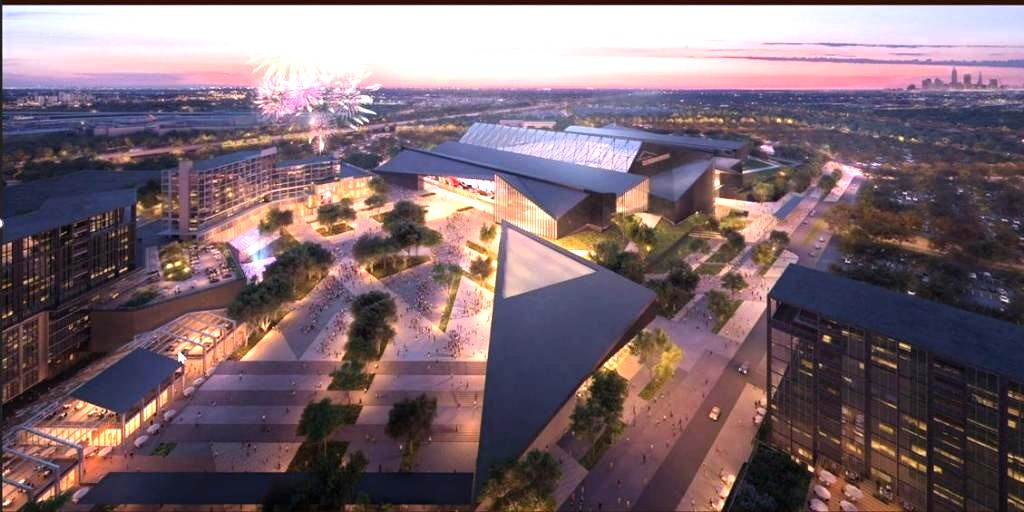
A confirmed genuine rendering of the Haslam Sports Group’s proposed Brook Park stadium and surrounding development shows multiple buildings of about 10-11 stories and perhaps others not visible. Perhaps two dozen such buildings would equal the reported non-stadium development investment of $1.4 billion (anonymous).
That was when the legal battle between the Cleveland-Cuyahoga County Port Authority and the George Group was still undecided over the George Group’s property at West 25th Street and the Detroit-Superior Bridge. The port wanted the property so it could stabilize the hillside above the Cuyahoga River for the future Irishtown Bend Park. The port ended up settling with the George Group last year.
Another potential stadium/development site was at and near the Main Post Office. It was also reportedly considered by the Haslams. But the Haslams apparently rejected this 80-acre site as too small and constrained by freeways and railroad tracks for its stadium/development needs. How big are those needs?
First, let’s turn to news reports by other media including WKRK-FM 92.3 The Fan’s Daryl Ruiter who noted that if the domed stadium is built in Brook Park, the Haslams will seek a massive development surrounding it. As a back-up plan, a $1.2 billion reconstruction of the existing 1999-built Cleveland Browns Stadium is also still on the table with roughly half of the cost publicly funded. The Browns’ lease at the current stadium expires after the 2028 football season.
But some of the numbers being thrown around are so large that they start to lose their relevance and context as to how big they really are. A $2.4 billion new stadium is planned off Snow Road in Brook Park, again with the public being asked to fund half the cost. That doesn’t include infrastructure costs to redesign roads, expand transit, relocate electrical utilities and construct sewers. And it doesn’t include the spinoff development.
For football fans and others attending events at a new domed stadium, they’re going to want restaurants, shops, hotels and other entertainment venues. And the Haslams are betting that all that stuff plus easy access to the airport, nearby freeways and the Red Line rapid into the city is going to present an attractive lifestyle for hundreds if not thousands of people to live in. So that means residential development too.
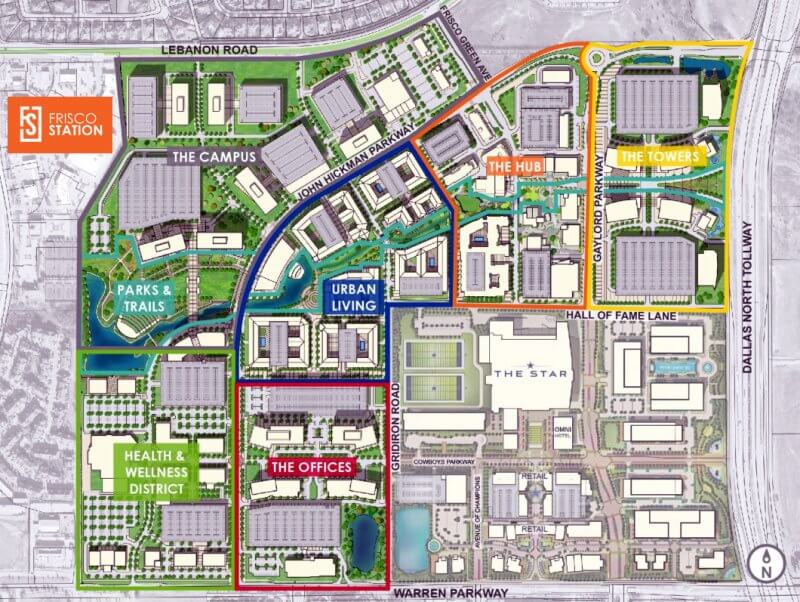
Owners of National Football League teams compete with each other on and off the field. That includes having real estate developments that can produce revenue that’s not subject to league-wide revenue sharing. This is the Dallas Cowboys’ practice facilities, hotels and shops at lower right. The next phases of development in the Dallas suburb of Frisco are shown around it (Dallas Cowboys).
All of that has a price tag that the Haslams have communicated to local media — $1.4 billion of privately financed development. Any number that starts with a “B” is difficult for many of us to comprehend. So let’s break that down to show what it means.
Typical costs for constructing new buildings vary with location, use, height and interior finishes. But for a mid-rise (five- to 10-story) luxury apartment building, a cost of $250 to $350 per square foot is common in a Midwest urban setting. Four-star hotels of a similar height can be more expensive since the rooms are usually smaller and the buildings have more on-site amenities; a cost of $300-$400 per square foot is typical.
Things get more expensive for office buildings which have to support the weight of more people, furniture and equipment. And they get more costly for high-rises, especially skyscrapers which require sturdier building frames atop a mat concrete foundation for high-rises or caissons to bedrock for 30-plus-story skyscrapers.
Applying those formula figures to a $1.4 billion investment may mean something in the neighborhood of 3.5 million to 5.6 million square feet of new apartments, hotels, restaurants and entertainment. The median is about 4.5 million square feet. Again, more big numbers that the Haslams can use to capture value to help finance a domed stadium.
How much is that square footage? For comparison, Sherwin-Williams’ new 36-story, 616-foot-tall headquarters skyscraper in Downtown Cleveland is a shade over 1 million square feet. So is Cleveland Clinic’s under-construction Neurological Institute on Carnegie Avenue. But it’s doubtful the Haslams are planning any one building so big.
Instead, smaller — but not small — buildings may be in the offing. A wellness facility like Bedrock’s 210,000-square-foot Cleveland Clinic Global Peak Performance Center by Tower City’s downtown riverfront might be possible. A competing health care system downtown, or a new one entering our market would be welcomed.
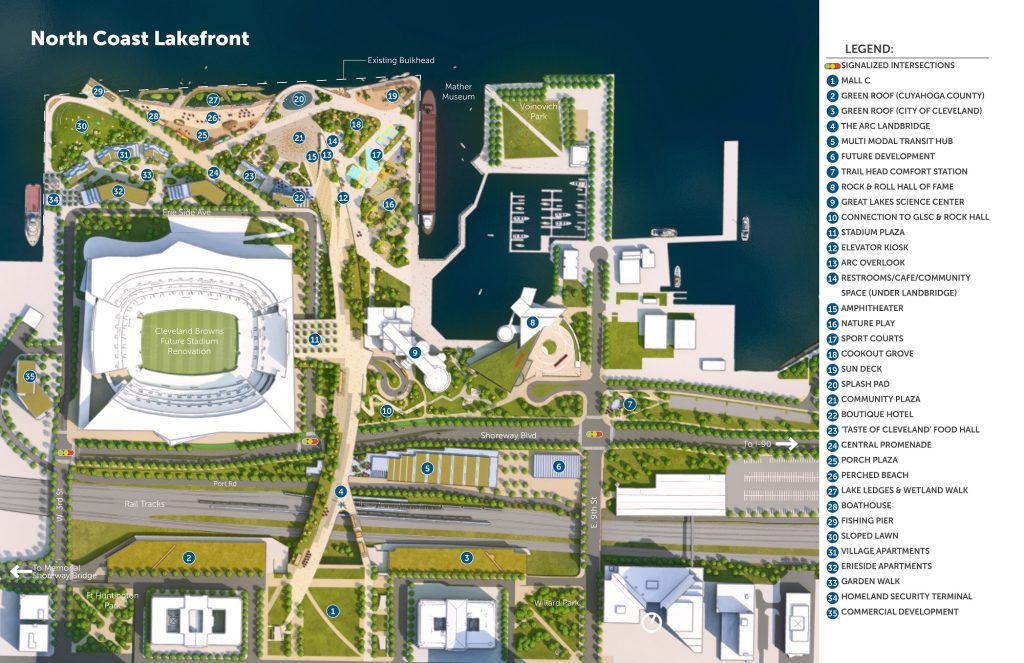
There isn’t room at Downtown Cleveland’s North Coast harbor for large scale spin-off development amid proposed publicly accessible recreation and park facilities to help finance a new domed stadium here. But there would be at Burke Lakefront Airport, if it were closed and offered up for development (FO).
It may be equally relevant to point to the new 23-story City Club Apartments tower downtown, which measures 250,000 square feet. Or, the 11-story Library Lofts in the Circle Square development in University Circle that’s due to open in August. It has 184,000 square feet (all studios and one-bedroom apartments) that includes a 28,000-square-foot MLK Branch Library.
Some of those look comparable in scale to the 10- to 12-story residential and hotel buildings plus a few low-rise buildings depicted in a Brook Park stadium site rendering. But a lot more of them would have to be built than what was visible in that rendering to account for $1.4 billion worth. How many?
Almost two dozen of them. That’s two dozen new buildings that would effectively create a small downtown-like area surrounding a new domed stadium. In other words, the Haslams are proposing a city-within-a-city.
Where should that be built? In Brook Park, next to a Ford Engine Plant and across the railroad tracks plus State Route 237 from Hopkins International Airport? Or on the huge site of a proposed-to-be-closed Burke Lakefront Airport, between a Great Lake and Downtown Cleveland? In the case of the latter, it may take a decade or two along with an interim stadium renovation, but those 450 acres might just be worth it.
END

